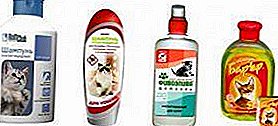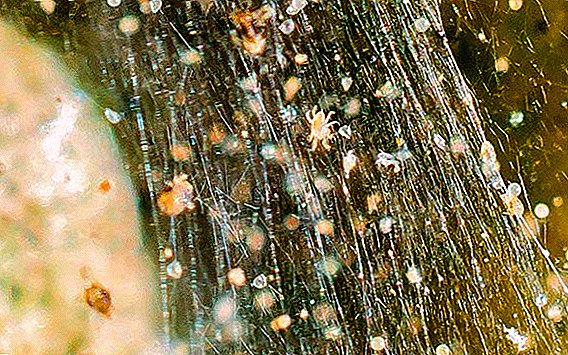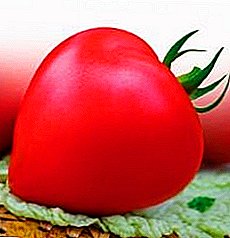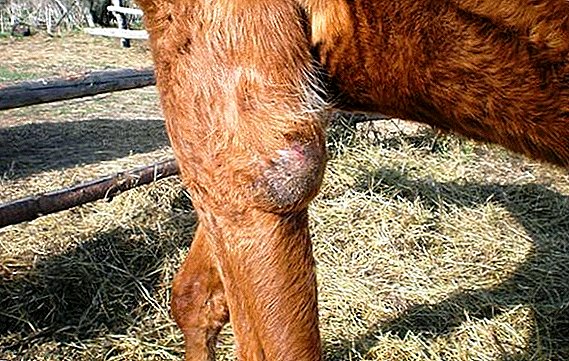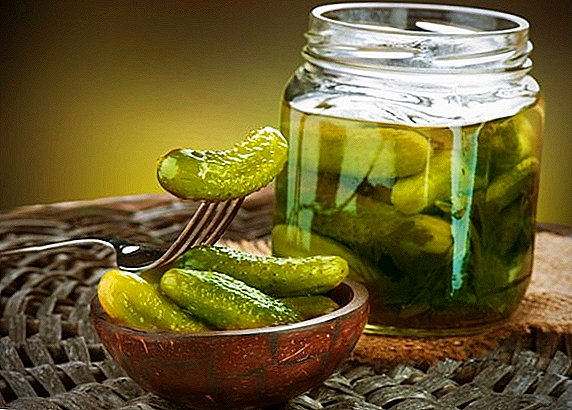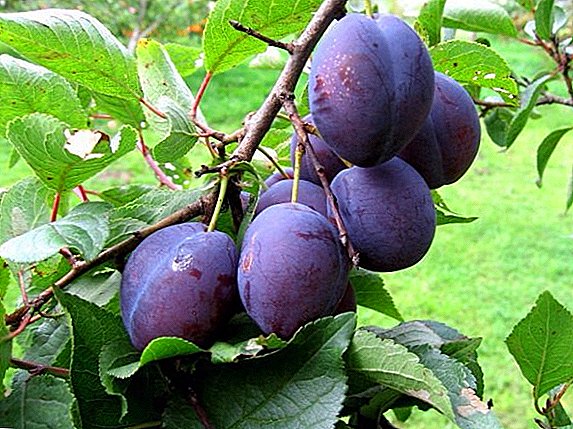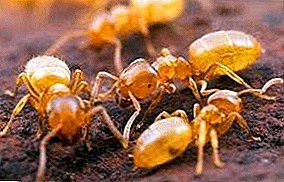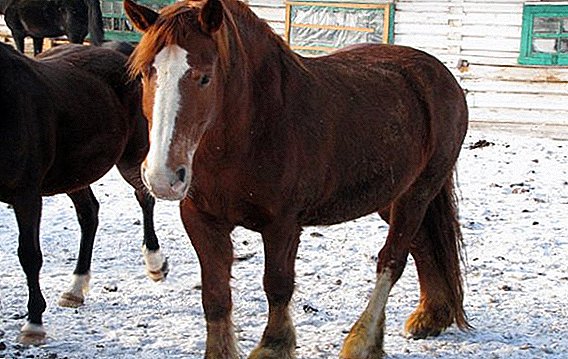 The maintenance of horses traction breeds on farms and in private farms today is no less popular than a hundred years ago. We will discuss about one of such breeds, namely about the Russian heavy draft, in this article - we will discuss the advantages and disadvantages of the breed, as well as the content and industries of application.
The maintenance of horses traction breeds on farms and in private farms today is no less popular than a hundred years ago. We will discuss about one of such breeds, namely about the Russian heavy draft, in this article - we will discuss the advantages and disadvantages of the breed, as well as the content and industries of application.
Breed history
The forefathers of the breed were the Arden horses, who lived in the Belgian mountains, which attracted people with endurance, unpretentiousness and strong build. After successfully carried out the work of crossing, the breed was obtained, adapted to the conditions of a temperate climate, its harsh winters.  The animal is not large, but nevertheless strong and obedient, which is important. At the horse show in France, a representative of the Russian heavy truck was awarded a gold medal. The breed was officially registered in 1952.
The animal is not large, but nevertheless strong and obedient, which is important. At the horse show in France, a representative of the Russian heavy truck was awarded a gold medal. The breed was officially registered in 1952.
Description and Features
A distinctive feature of heavy trucks is a strong and muscular body. They can not demonstrate good speed, but perfectly cope with the obstacle course.
Did you know? The maximum weight that the Russian heavy truck can move is 14.5 tons.
Appearance
The breed has its own standards of appearance:
- growth - 150-153 cm;
- weight - two-year-old stallion - up to 700 kg, mares - up to 660 kg;
- head - medium size with a long muzzle and a broad frontal part with a bang, a muscular, strong, short neck;
- body - straight muscular shoulders, long developed back, wide withers, deep chest and even lumbar region;
- limbs - smooth, widely spaced, have brushes;
- mane - thick and long;
- tail - thick, hanging freely;
- suit - red, black and red-chalaya, you must have white markings on the legs and face.

Character
Horses are balanced and calm, differ in obedience and loyalty to the owner. Heavy duty active in work, peace-loving and good-natured. The horse quickly gets used to the conditions of detention and the duties imposed on it.
Not whimsical and not whimsical, can bump, if there is a reason - for example, poor health or owner's mistake in caring for a pet.
Advantages and disadvantages
The breed is bred not only as a labor force, but also for the production of milk and meat, rare varieties of cheese are prepared from the milk of a heavy truck.
Such breeds as the Vladimir and Soviet heavy trucks are also classified as heavy.
In addition, the breed has other advantages:
- adaptability to conditions;
- unpretentiousness in feed;
- calm temper;
- rapid puberty;
- versatility of application;
- strength and endurance;
- strong nervous system.
 Gradual degeneration is considered to be a drawback to draft, since mixing with other breeds has a negative effect on the distinctive characteristics. Purebred mares and stallions are extremely small.
Gradual degeneration is considered to be a drawback to draft, since mixing with other breeds has a negative effect on the distinctive characteristics. Purebred mares and stallions are extremely small.Scope of application
Russian heavy farm is grown for meat and milk, used in agriculture as a traction horse, for the transport of goods and as a work in the fields. In addition, a good temper allows you to use the animal in the tourism business, as a riding horse, including for children, and a pack animal.
Many breeders purchase heavy horses for riding or sledding.
Did you know? In the famous Russian animated series about three heroes, the Russian heavy truck was used as a prototype of the powerful horse.
Maintenance and care
Despite the simplicity of the conditions of detention, some rules still follow, especially with regard to animal hygiene. 
Stable conditions
The maintenance of horses is carried out in accordance with such rules and regulations:
- Horses contained in the so-called stalls. Size per individual - 3,5x3,5 m, not less. The ceiling height is about three meters. Drafts are contraindicated, so there should not be any cracks in the room; ventilation must be present for continuous access of fresh air.
- Straw or sawdust is used as a litter; it is laid at least 15 centimeters high.
- Feeders and drinkers should be placed on the reverse side of the fence at a height of approximately 60 cm, they should be made of natural non-toxic material with a depth of up to 30 cm so that the feed does not crumble.
- 16-hour lighting, with a brightness of about 150-200 lux, is scientifically justified; in winter, this method eliminates the winter lethality inherent in horses.
- There should be a paddock near the enclosed area.
Learn how to harness horses.
Cleaning and hygiene
Do not neglect the rules of hygiene:
- daily cleaning bedding, feeders and drinkers cleaned;
- also horse wool should be cleaned daily, while each pet has its own scraper, comb and brush. After mechanical dry cleaning, wipe with a damp, soft cloth. Then dry with a dry cloth wool. Combing the mane, bangs and brushes;
- horse bathing is carried out only in the summer, warm period. If the animal is not afraid of water, you can bathe in a natural pond, otherwise use a bath with a hose.
- absolutely necessary every day, especially after walking to inspect the hoovesin which slivers or small pebbles can get stuck. For injuries, contact your veterinarian;
- regularly examine the teeth of pets, try to smell to their breath. An unpleasant smell is a signal of ill health. Enamel should be intact, without chipping and cracking, the gum is pink, the line of teeth is even;
- A sad animal is important not to touch the teeth with the bits: they crumble easily;
- watch how the pet eats. If he shakes his head, perhaps he has problems with his teeth, and he is trying to get rid of the pain. It is necessary to check the growth of teeth in foals from the age of nine months, to observe the veterinarian, who will be able to eliminate the wrong bite or "wolf tooth" in time.

Proper feeding
Feeding horses is carried out about five times a day, the daily ration includes:
- oats - up to 7 kg;
- hay - up to 13 kg;
- bran - up to 1.5 kg;
- carrots, fodder beets - up to 2 kg.
Important! When you clean a horse, bathe it - this is a chance to examine its skin well for injuries or wounds. Thus, the procedure is wellness in nature.
In summer, grazing walking is organized for pets in areas with lush green grass, except for her, fed with concentrated feed. Briquettes with salt are also needed, which will provide the body with essential minerals.
Twice a day, at least the heavy trucks should drink plenty, the water must be at room temperature - about 20 degrees. Foal mares should receive 30% more feed than they normally would.  The health of your pet, its mood and desire to work depend on compliance with the rules of care, feeding and daily hygiene procedures. This breed is distinguished by great affection and friendliness towards a person, your sincere care will be rewarded a hundredfold.
The health of your pet, its mood and desire to work depend on compliance with the rules of care, feeding and daily hygiene procedures. This breed is distinguished by great affection and friendliness towards a person, your sincere care will be rewarded a hundredfold.


